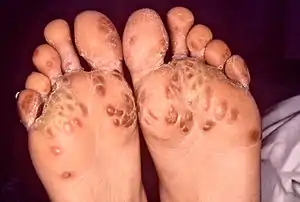Keratoderma blennorrhagicum
Keratoderma blennorrhagicum etymologically meaning keratinized (kerato-) skin (derma-) mucousy (blenno-) discharge (-rrhagia) (also called keratoderma blennorrhagica)[1] are skin lesions commonly found on the palms and soles but which may spread to the scrotum, scalp and trunk. The lesions may resemble psoriasis.[2]: 195
| Keratoderma blennorrhagicum | |
|---|---|
 | |
| The rash on the bottom of this individual’s feet, known as keratoderma blennorrhagicum, was due to reactive arthritis | |
| Specialty | Dermatology |
Keratoderma blennorrhagicum is commonly seen as an additional feature of reactive arthritis in almost 15% of male patients. The appearance is usually of a vesico-pustular waxy lesion with a yellow brown colour. These lesions may join to form larger crusty plaques with desquamating edges.
References
- Rapini, Ronald P.; Bolognia, Jean L.; Jorizzo, Joseph L. (2007). Dermatology: 2-Volume Set. St. Louis: Mosby. p. 124. ISBN 978-1-4160-2999-1.
- James, William; Berger, Timothy; Elston, Dirk (2005). Andrews' Diseases of the Skin: Clinical Dermatology. (10th ed.). Saunders. ISBN 0-7216-2921-0.
External links
This article is issued from Wikipedia. The text is licensed under Creative Commons - Attribution - Sharealike. Additional terms may apply for the media files.